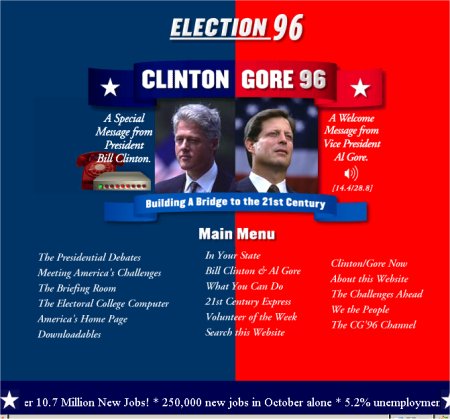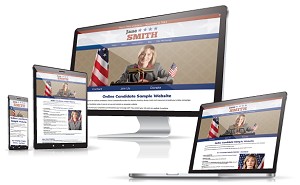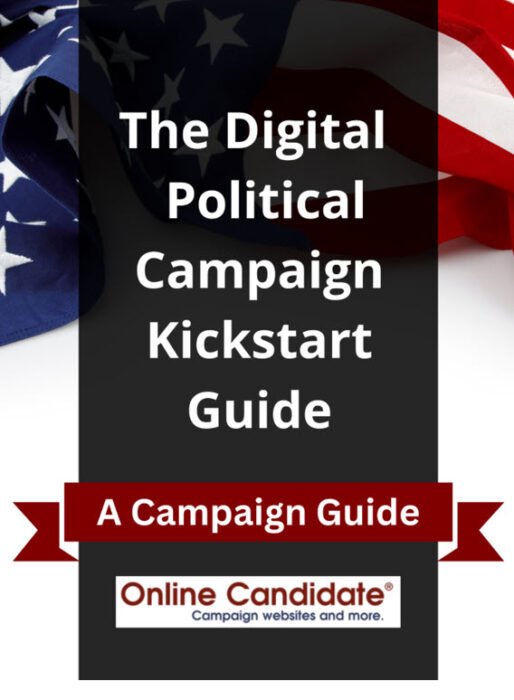Political Web Design Trends Over The Decades
 Over the seven years that we’ve been building political websites, politics online has taken a lot of different turns. Social media, blogging, online donations and the adoption of video have really changed how candidates and voters interact. With these changes in technology there have also been changes in political website design trends and styles.
Over the seven years that we’ve been building political websites, politics online has taken a lot of different turns. Social media, blogging, online donations and the adoption of video have really changed how candidates and voters interact. With these changes in technology there have also been changes in political website design trends and styles.
Here are some of the biggest changes we’ve seen since we started political web design in 2003:
Site width
Around 2003, the average monitor was set at a 800×600 pixel resolution, which meant that our campaign websites were built at 780 pixels wide or less, so the entire site could be seen without left or right scrolling.
As of last month, less than 2% of visitors to this website had a screen resolution of 800X600 or less. Our typical site is usually 1100 pixels wide, though some candidates request even greater widths. One reason we don’t recommend going too wide is that it become difficult to read the content of the pages when each line of text is 40-50 words long. It’s easier for users to read in narrow columns.
Website headers
Because of the average screen resolution, you didn’t want to have a head that was too deep. Anything deeper than 150 pixels started to take up a lot of space. Over the last few years candidates have requested much larger headers on their sites, along with larger candidate photos.
Navigation
Years ago, our site navigation text was usually bold in a narrow column. This was more the style of the times than because it looked particularly well. In 2010, we’ve seen a dramatic shift in design requests. Color rollovers are still popular, though the trend has been for the navigation bar to be wider with larger text. A few of our recent sites have the navigation appearing as large ‘buttons’ that roll over with alternate colors. The larger donate and volunteer buttons that a lot of national political sites favor probably influence this style. In some cases, the entire site needs to be widened to accommodate this design.
Colors – red, white and blue
Red, white and blue are still favorite color schemes for US campaigns, though the colors tend toward darker reds and more purple blues. Some candidates go for greens or yellows. We always try to match their campaign material or create a complementary color scheme.
Text and copy layout
We’ve always encouraged our clients to use bullet points in their copy, organize text with sub headers, and use images to break up areas of text. These days most of our clients do a great job in laying out content. (In the past, sometimes not so much.) We’re always glad to help tweak body copy if someone needs help, because when the design and content both look good, it all comes together!
Other web features whose popularity has faded include text in multiple colors and reverse backgrounds, blinking text and those annoying web counter buttons that proudly display to the world how many ‘hits’ your page has. But one thing that’s increased over the years are the donation buttons… they seem to be everywhere now!
What other political changes online have you seen over the years?
Check out a selection of our own more current political website examples.
Related: Political Web Design: A Primer
Political Pay-Per-Click Advertising Ideas
 If you are using Google Adwords or other text advertising networks to promote your campaign, you are likely buying text ads on keywords related to your candidate’s name, your opponents’ names and on issues relevant to your race. Those are the most obvious terms, and they work well. But here are some long-tail keyword suggestions that you may not have considered for your pay-per-click campaign…
If you are using Google Adwords or other text advertising networks to promote your campaign, you are likely buying text ads on keywords related to your candidate’s name, your opponents’ names and on issues relevant to your race. Those are the most obvious terms, and they work well. But here are some long-tail keyword suggestions that you may not have considered for your pay-per-click campaign…
THIS POST HAS BEEN REDIRECTED TO: https://www.onlinecandidate.com/articles/online-advertising-local-political-campaigns
Types of people: Have a campaign issue that is specific to particular voter demographic? Create an ad specific to them. For example, if the issue is about a local hospital closing down, create an ad about your candidate’s position on the closing and bid on local keywords variants related to local hospitals and health clinics. Have the ad link directly to the issue or position page on your website.
Local businesses and organizations: Targeting a particular type of voter – perhaps one that would frequent a particular business or belongs to a certain organization? Try bidding on that name with an ad targeted toward that demographic.
Geographic areas: Go broad and target any searches related to your area. This can get expensive, of course, but it’s a way to put yourself before a larger audience. These broad terms might be best held off until the end of the campaign cycle as part of an overall ad blitz.
News stories: Bid on phrases related to topical stories and link the ads to your relevant issue or press release pages.
Endorsements: Bid on the names of any organizations that have endorsed you. Link to your endorsement page, press release or issue page that relates to that organization.
Targeting PPC ads with such refined niches takes a lot of planning and a lot of testing to deliver highly targeted messaging. Ads will need to be broken into groups, and then broken down further as new niches are discovered. Some ads will have low click-through rates and others will perform well. Tracking how well each ad performed in clicks, e-mail sign-ups and donations will help you make the most of your advertising dollars.
Remember that landing pages are critical to any ad campaign. Your landing page should match your ad’s theme. If you run ads, you may want to tweak your pages to make them ‘fit’ your ads better. It’s important that the content a visitor sees relates to the ad they clicked on. The better the landing page, the more likely that a visitor will sign up for your email list, volunteer or make a campaign contribution!
Related: How Candidates Raise Money For Local Campaigns
Looking for letter templates that cover all aspects of a local political campaign? Save time and effort with our Campaign Letter Templates. Visit our Download Store for more digital items.
Learn More About Your Campaign Website Visitors
![]() Website analytics is a tool that provides important data concerning the visitors to a website, how they interact with the site, and even details that can help increase traffic. While most website hosting provides an ‘analytics package’, such as AWStats or Webalizer, the reporting and data provided is fairly crude. Google provides a free, professional-quality analytics package that is easily incorporated into almost any website.
Website analytics is a tool that provides important data concerning the visitors to a website, how they interact with the site, and even details that can help increase traffic. While most website hosting provides an ‘analytics package’, such as AWStats or Webalizer, the reporting and data provided is fairly crude. Google provides a free, professional-quality analytics package that is easily incorporated into almost any website.
For political campaign websites, it’s definitely worth knowing where your site visitors are coming from and what they are doing on your site.
To set up an account for Google Analytics, visit www.google.com/analytics. You will be asked to sign in to your Google Account or to create a new Account if you don’t have one.
Click the ‘Create Website Profile’ link to add a new website. You’ll be given the choice to add a Profile for a new domain or for an existing domain. You’ll usually start with new domain.
Below that, provide Google with the URL of the site you wish to add. You will also have the option of applying cost data from your Adwords account (if you have one set up under the same account).
Click Finish.
Google will provide you with a block of tracking code. Copy this, as you’ll need to copy and paste this HTML code directly into each page of your site, just above the </body> tag.
For Online Candidate websites, go to the Site Setup page and add the code into the ‘Custom Code Insertion’ section.
That’s it! If everything is set up correctly, you’ll be able to see traffic statistics in your reports within an hour.
While Google Analytics is simple to install, the program can perform very deep analysis of traffic patterns and success metrics. For the less experienced user, there are two basic questions that require answers.
1) Where do your Visitors come from?
This is one of the most important type of data to provide insights into your visitors. The ‘Traffic Sources’ category displays the websites and keywords which send traffic to your website. This can be broken down further into:
Direct Traffic: The number of visitors who came to the website by entering a URL into their web browser.
Referring Sites: Referring websites are sites which send visitors to your campaign website. The visitors get referenced from the source website and land on the target website using the link provided. Referring websites can be used to judge the success of social media marketing techniques.
Search Engines: This contains a list of the search engines which were used to send traffic to the site.
Keywords: These are the terms that were searched by visitors that led to them clicking through to the website.
2) What are your visitors doing on the Website?
Analysis of this data enables you to track visitors actions on the website. You can find out what pages were looked at, for how long, and whether they were the first or last pages a visitor saw. The Content category in the left sidebar of Google Analytics provides this data:
Top Content: This contains a list of the most popular content as viewed by visitors.
Top Landing Pages: These list the pages visitors first land on. You can examine the browsing path for each webpage to determine traffic patterns and whether they engage the visitors well.
Top Exit Pages: This contains a list of pages which led visitors to exit the website. Pages with a high exit rate should be examined for improvements to keep the visitor on the site or do perform a set task (such as an email signup or donation).
Site Overlay: The Site Overlay opens a new web page which contains a progress bar over every link. These bars shows the percentage of the overall number of page clicks on that link.
Note that in these reports, the ‘Bounce Rate‘ listed is the percentage of visitors that landed on a particular page and immediately left the site. A high bounce rate indicates that visitors are not finding that particular content engaging.
More advanced uses might want to track how visitors get to a certain page like a volunteer signup form or a donation page. To do that, you will need to create goals and funnels. The Goals category of Google Analytics helps you to set a goal or goal path. By segmenting traffic, you can find out how many visitors completed or did not complete your goals, the overall value of your goals, and what sources of traffic performed best.
For additional information and user tips, visit the Google Analytics blog.
Looking for letter templates that cover ALL aspects of a local political campaign? Save time and effort with our Campaign Letter Templates from our Download Store.
5 Tips For Creating Effective Campaign Surveys
Politics lives and breathes on voter polls and surveys. For local candidates with limited budgets, there are online survey tools that can gather feedback in order to perfect a campaign’s message and methods. Campaign surveys can be sent to participants in several ways: through a website link, via your email list, or through off-line contact, such as an invitation through campaign brochures and pamphlets.
Online Candidate websites include a built-in poll feature, but for candidates that want to build out detailed surveys, there are a number of free and paid options out there. These include surveymonkey.com, freeonlinesurveys.com and zoomerang.com. A well-structured survey can provide a useful tool to provide insight into what issues are important to voters.
Below are some basic tips to help make your online survey effective and inviting to participants.
Determine your goals
When creating an online survey, define your objectives. What is it that you are trying to learn? What specific data will the survey yield that can help your political campaign? Don’t set up your survey to be all things to all issues. If you want to know what issues are important to your constituents, ask them. If you want to know the specifics of a particular issue, perhaps those questions should be asked in a separate survey.
Keep your survey short
If asking for general feedback, keep your survey short and to the point. Nobody likes getting suckered into a ‘short’ survey only to find after the first five questions they are only one tenth of the way through!
Keep the questions short and tight, so there is no ambiguity on the part of the reader. For example, don’t ask “What do you think of the commercial building moratorium?” Rather, make the question more specific, such as “Do you approve of the commercial building moratorium?”
For somewhat longer surveys or where you are looking for answers from only a particular subset of respondents, consider adding skip logic. This means that you can direct a respondent to a tailored set of questions and prevent readers from answering irrelevant questions. So if you ask on the first question, “Are you a homeowner?”, the answer provided may or may not lead to additional follow-up questions for that respondent.
Make it private
With any survey, it’s important for respondents to know how their replies are handled. Participation and honesty of answers generally increases if responses are completely anonymous. If you do collect personalized information, let the respondents know how their data will be kept and what privacy you provide.
Randomize answers
Some survey systems allow for answer choices to be randomized for each respondent. This method helps reduce bias. The answers also tend to become more statistically relevant. However, do not randomize answers for states or number ranges that are to be listed alphabetically or numerically.
Test, test, test!
Before launching your survey, be sure to thoroughly test. You may want to have a few outsiders take the survey and provide feedback on how clear the questions and answers were. One common problem is in answers where the participant is asked to choose more than one selection. If the answer structure is not set up right, such as using radio buttons rather than check boxes, then users will not be able to answer the questions properly. Be sure to check all permutations of the answers.
Numbers can be skewed
Online survey that are open to all visitors are prone to manipulation. Simply by deleting cookies, a user can answer the same survey over and over. Because of this, online surveys should not take the place of professional polling. It’s best not to publish the final results if you suspect that a poll has been manipulated. Unless you’re running a very simple survey, it’s probably a good idea not to allow results before the participant has taken the survey themselves.
Finally at the completion of a survey, always invite the participants to join your mail list or follow or fan you on Facebook or Twitter, so they can keep following your campaign.
Campaign Website Widgets That Really Add Value
For those who missed them, here are some posts related to cool widgets, gadgets and updates that can be easily added to any political campaign website.
Add a Custom District Map to Your Campaign Website
Here are the steps to take in order to add a nice, interactive political district map to your campaign website.
Generating an Online Signature
Many candidates use the home page of their campaign website to personally address voters or constituents. What kills the illusion of an online ‘letter’ is the lack of a handwritten signature. Here are a few ways to generate a realistic-looking signature for your web pages.
Effectively Using Video for a Local Campaign
Learn a few ways to get the most out of online video for your campaign.
PDF Your Campaign Materials
Save money by having your supporters print their own campaign materials. Make your entire media kit available online for download.
Fundraising with Widgets
Candidates can use widgets in a variety of ways to help get out the word and raise money.
Sell Fundraising Tickets in Advance – Online
In addition to using online donation buttons to accept campaign donation online, create specific buttons to sell tickets to fundraisers or other political campaign events.
Add-ons that create real value for your site should only be used. Weather and date widgets are so 1999, and local news feeds that are not related to your campaign are only distractions that send visitors away from your site.
Looking for letter templates that cover all aspects of a local political campaign? Save time and effort with our Political Letter Templates. Visit our Download Store for more digital items.
Why Local Political Candidates Need Thick Skins
The more public the figure, the bigger the target for attack. And if you are a candidate running for office, then, like it or not, you are considered a public figure.
This means that legally, a candidate can do little against unflattering letters to the editor, misquoted articles, and underhanded brochures containing vicious rumors. What is said can be completely false.
A lie, even.
A candidate can sue for libel, but unless they can prove the statement was both false and malicious, they won’t have a case. Proving malice or a level of carelessness that amounted to maliciousness is a burden of proof that is tough to meet. This is established law based on the United States Supreme Court ruling in New York Times v. Sullivan.
Unflattering or untrue statements can make it hard for a candidate to keep his or her cool. That’s why a thick skin is important, because lashing out will either justify the attacks or just make the candidate look bad. Legitimate issues should be confronted, but a candidate should not feel the need to address every crank out there. The same holds true for online activities.
It seems like the smaller the district, the more personal and nastier the politics. If a candidate can avoid the sleaze, they will not only hold the moral high ground, but they will also be better able to focus on the real objective: winning the election.
And what if it’s legitimate criticism that you get called out for? Take constructive criticism and use it as an opportunity for growth.
Start your online campaign website and social media setup with an Online Candidate website.





